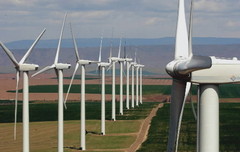forum
library
tutorial
contact

Northwest Wind Power:
My, How You've Grown
by Editorial BoardThe Oregonian, August 15, 2009
|
the film forum library tutorial contact |

|
Northwest Wind Power:
by Editorial Board |
 For the past decade, Northwest policymakers have treated wind energy like a newborn, lavishing it with political love and bathing it in tax credits and other incentives.
For the past decade, Northwest policymakers have treated wind energy like a newborn, lavishing it with political love and bathing it in tax credits and other incentives.
All the attention has paid off: Wind has grown from a bouncy little bundle of renewable energy to a big boy in electricity production. Wind generation in the Northwest has nearly doubled each of the past four years. Now the thousands of spinning blades in the Columbia Gorge have the capacity to produce more than 2,000 megawatts -- meaning wind farms can churn out the equivalent of two Bonneville dams. And with wind generation predicted to double again in two years, it will soon grow to the whopping size of four Bonnevilles.
It's time not only for the Northwest to recognize that wind is growing up, but that it's rapid expansion poses challenges that the region's policymakers and the wind industry itself have been slow to recognize, accept and address.
Two recent events should spur a broader public discussion about wind power. One was Bonneville Power Administration's announcement that it will increase by 90 percent the rate it charges wind producers to absorb and smooth out the intermittent stream of power sent onto the grid. The other was Gov. Ted Kulongoski's veto of a bill that would have cut tax credits to large wind energy projects.
The issues surrounding the BPA's rate ruling are complicated, but they are worth understanding because it is the region's first clear-eyed plan to deal with the challenges of wind energy. Bonneville's chief executive, Steve Wright, has been on the defensive about his agency's stance on wind since early this year when it proposed a 300-percent increase in wind energy rates.
In hindsight, it's clear that shocking rate proposal was useful in propelling the wind industry, utilities and others to take seriously the stress that wind puts on Bonneville's system.
Most of the region's windfarms are clustered in an egg shape around the windy Columbia Gorge. The concentrated development intensifies the major ramping events on the system -- when the wind blows, the wind farms send power to the grid at the same time; when the wind stalls, all the production plunges.
Bonneville uses its hydro system to balance the ups and downs of wind. But that means manipulating the Columbia River, which comes with substantial costs, some of them, potentially, to threatened salmon.
It looks as though Wright and others have worked out not only a fair rate increase for wind, but also a plan that will ensure that the BPA can accommodate the anticipated huge growth in wind production. For their part, wind producers now seem committed to making a much greater effort to accurately forecast and schedule their output. The BPA is installing 16 stations to measure wind speed and direction around the region to provide data to wind operators at five-minute intervals.
It is noteworthy that the American Wind Energy Association and other industry groups praised BPA's final rate increase. "Bonneville has taken steps on transmission that lead other utilities around the country," said Rob Gramlich, senior vice president of the American Wind Energy Association. All this suggests that the BPA and wind producers are finally recognizing that wind is a rapidly maturing industry in the Northwest, one big enough to demand more sophisticated and nuanced policies.
It's not clear, though, whether Oregon's leaders fully understand the strong new wind industry, or why it's growing so quickly. When Kulongoski issued his notice to veto a bill that would cut state tax credits for wind projects, he and others argued that reducing tax subsidies would deter wind development.
In fact, wind is coming to Oregon with or without $10 million-a-project tax credits. The influx is driven by California's renewable energy portfolio standard requiring utilities, by 2020, to get a full third of their power from renewable sources. Oregon, too, has a renewable portfolio standard, but it is less aggressive, requiring 25 percent green energy by 2025.
These standards compel utilities to pay whatever it takes to acquire wind and other renewable energy. That demand will continue to drive wind projects in the region. Oregon's tax credits do provide an incentive to site windmills here, rather than in Washington. But there's a case to be made that taxpayers are subsidizing wind farms that would be built here anyway to meet the thirst for renewables in California and other states.
The governor's veto, and much of the accompanying rhetoric from green energy advocates, seemed to suggest that wind remains this vulnerable little industry that still needs every subsidy it can get. If you believe that, take a ride up the Columbia Gorge, or better yet, a flight over what is now the Northwest's wind country.
None of this is meant to criticize wind as a source of renewable energy, economic activity or jobs. It is, flat out, a great industry for the Northwest. But it's time to see wind for what it is -- a big, strong, clean and yet challenging source of energy. It doesn't need to be babied any longer.
learn more on topics covered in the film
see the video
read the script
learn the songs
discussion forum
